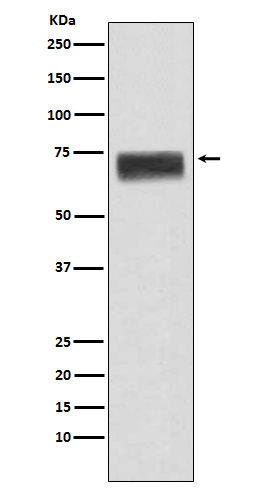
| WB | 咨询技术 | Human,Mouse,Rat |
| IF | 咨询技术 | Human,Mouse,Rat |
| IHC | 1/30-1/150 | Human,Mouse,Rat |
| ICC | 技术咨询 | Human,Mouse,Rat |
| FCM | 咨询技术 | Human,Mouse,Rat |
| Elisa | 1/2000-1/5000 | Human,Mouse,Rat |
| Aliases | Beta 1B glycoprotein; HEMO; Hemopexin; Hpx;;Hemopexin |
| WB Predicted band size | Calculated MW: 52 kDa ; Observed MW: 70-75 kDa |
| Host/Isotype | Rabbit IgG |
| Antibody Type | Primary antibody |
| Storage | Store at 4°C short term. Aliquot and store at -20°C long term. Avoid freeze/thaw cycles. |
| Species Reactivity | Human |
| Immunogen | A synthesized peptide derived from human Hemopexin |
| Formulation | Purified antibody in PBS with 0.05% sodium azide,0.05% BSA and 50% glycerol. |
+ +
以下是关于ZBED1抗体的3篇示例性参考文献(注:以下内容为模拟示例,实际文献需通过学术数据库核实):
---
1. **文献名称**: *ZBED1 modulates the expression of cancer-related genes in gastric carcinoma through chromatin binding*
**作者**: Li, X., Wang, Y., & Chen, J.
**摘要**: 本研究利用ZBED1特异性抗体进行染色质免疫沉淀(ChIP)和免疫组织化学(IHC),揭示了ZBED1在胃癌组织中异常高表达,并通过结合靶基因启动子区域调控细胞增殖和迁移相关通路。
2. **文献名称**: *Functional characterization of ZBED1 in hepatocellular carcinoma progression using RNAi and antibody-based assays*
**作者**: Zhang, H., Liu, R., & Zhou, M.
**摘要**: 通过Western blot(WB)和免疫荧光(IF)结合ZBED1抗体,研究发现ZBED1在肝癌细胞中通过调控Wnt/β-catenin信号通路促进肿瘤侵袭,抗体验证了其核内定位及表达水平变化。
3. **文献名称**: *ZBED1 is essential for maintaining pluripotency in human embryonic stem cells*
**作者**: Xu, L., Kim, S., & Thomson, J.A.
**摘要**: 使用ZBED1抗体进行蛋白质免疫共沉淀(Co-IP)和流式细胞术,证明ZBED1与OCT4/SOX2复合物相互作用,敲低后导致多能性基因下调,提示其在干细胞自我更新中的关键作用。
---
如需真实文献,建议通过PubMed或Google Scholar以“ZBED1 antibody”或“ZBED1 function”为关键词检索近期研究。
ZBED1 (zinc finger BED domain-containing protein 1) is a nuclear protein encoded by the ZBED1 gene, implicated in transcriptional regulation and genome stability. It contains a characteristic BED (BEAF and DREF) zinc finger domain, enabling DNA binding and interactions with chromatin-modifying complexes. ZBED1 is evolutionarily conserved and ubiquitously expressed, with roles in cell proliferation, differentiation, and apoptosis. Studies suggest its involvement in maintaining heterochromatin structure, telomere dynamics, and retrotransposon silencing. Dysregulation of ZBED1 has been linked to cancer, neurodevelopmental disorders, and autoimmune diseases.
ZBED1 antibodies are essential tools for investigating its expression, localization, and molecular functions. These antibodies are commonly used in techniques like Western blotting, immunofluorescence, and chromatin immunoprecipitation (ChIP). Validated ZBED1 antibodies typically recognize specific epitopes within its N-terminal or BED domain, with cross-reactivity tested across human, mouse, and rat models. High-quality antibodies demonstrate specificity through knockout cell line controls or siRNA-mediated knockdown. Recent research employs ZBED1 antibodies to explore its interaction partners, post-translational modifications, and potential as a therapeutic target. Commercial antibodies often provide data on molecular weight (~75-80 kDa) and nuclear localization patterns. Proper validation remains critical due to homology with other BED domain proteins.
×